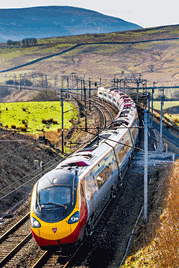 Read the peer reviews for this feature.
Read the peer reviews for this feature.
Download the graphs for this feature.
Today’s railway makes much of the lower costs that electric trains bring. They cost less to buy and less to maintain than diesel trains. They do come with a capital cost incurred to erect overhead wires and associated power equipment, but they generate lower track costs and lower fuel costs (see table).
All good reasons to switch… but there’s another, more important, reason. Attributed to John Aspinall, general manager of the Lancashire and Yorkshire Railway from 1899, are these words: “Electrification is carried out not to save money, but to make more.”
His words hint at what was later described as the ‘Sparks Effect’ - the increase in passengers that followed successful electrification schemes. BR London Midland Region General Manager Henry Johnson reported in 1968 that traffic rose 59% on London-Manchester and 60% on London-Liverpool services in the first four weeks after they converted to electric trains. Receipts rose 53% and 47% respectively. Over the first year both routes experienced increases in passengers of around 55% and increases in receipts of around 39%.
Yet it was Johnson who had suspended West Coast Main Line electrification when he was appointed to the top LMR job in 1962. What today might be called a ‘pause’ took place, to allow a project review to check whether it was justified. The review cost the project a year and led to some quieter lines being dropped.
For his part, Aspinall electrified two routes: Liverpool-Southport/Crossens/Ormskirk and Manchester-Bury-Holcombe Brook. While Holcombe Brook closed in 1960 having lost its electrification in 1951, today Manchester Metrolink runs electric trams to Bury while Merseyrail runs EMUs to Southport and Ormskirk (Crossens closed in 1964).
They could be described as the exceptions to a rule that electrification is often talked about but rarely implemented. Consider that the North Eastern Railway had plans in 1919 to wire York-Newcastle. The Great Western Railway commissioned a scheme in 1927 to electrify Taunton to Penzance. Bringing electric trains to the Great Northern suburban network from King’s Cross was considered as far back as 1903, but it was 1976 before passengers were carried on electric trains (the same Class 313s in which they travel today).
Despite offering good returns - a 1981 report by the Department of Transport and the British Railways Board reckoned 11% - the history of electrification contains more cancellations than openings. As former Network Rail electrification expert Peter Dearman told an Institution of Mechanical Engineers (IMechE) conference in June 2015: “When the cost goes up or the economy goes down, enthusiasm wanes.”
And costs have certainly gone up. Network Rail’s Great Western scheme has risen from £1.6 billion in 2014 to £2.8bn in 2015. When it was first announced in 2009, the Department for Transport had put the cost at £1.1bn, including a separate Liverpool-Manchester scheme.
Secretary of State for Transport at the time was Andrew Adonis, who said: “Over the medium term this £1.1bn investment in electrification will be self-financing, paying for itself through lower train maintenance, leasing and operating costs. This means that this investment can take place without reducing already planned infrastructure enhancement work.”
In its 2009 electrification strategy, NR said: “Two schemes - the Great Western Main Line and the Midland Main Line - have particularly high BCRs without dependency on further electrification. In the case of Midland Main Line the value is technically infinite given that it involves a net industry cost saving rather than a cost.
“The Great Western Main Line BCR lies in the range from ‘high value for money’ to ‘financially positive’ over the appraisal period, depending upon IEP cost assumptions. There is an upfront investment requirement for Network Rail which is potentially offset by lifetime cost savings, largely in the costs of train operation.”
Tripling the bill hugely extends the payback period. When consultant Merz and McLennan analysed a London-Doncaster-Leeds/Lincolnshire lines scheme for 1931’s Weir Report, it found a return of 7.2% on a capital outlay of £8.6 million. Tripling that outlay cost cuts the return on capital to 2.4%.
Yet NR’s 2009 strategy makes little reference to infrastructure costs as a driver of BCRs, and instead concentrates on how rolling stock costs might change. Taking an optimistic tone, it suggests: “Network Rail, working with its supply chain, would develop efficient delivery mechanisms to ensure the work would be undertaken at low benchmarked unit costs with minimal disruption to users.”
It’s not hard to imagine that had the DfT not already signed an expensive contract for electric trains, the whole GW project would have been cancelled. That today’s politicians continue to support rail’s plans would surely amaze their predecessors. It should shame railwaymen, because they don’t deserve that support having presided over such an increase in costs.











